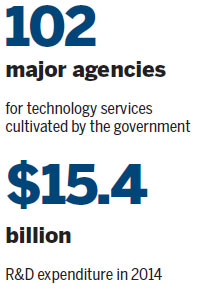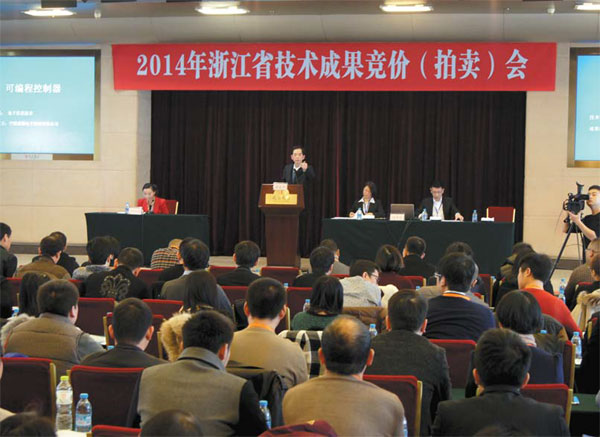Province advances innovation services
Zhejiang province plans to make more efforts to encourage scientific and technological innovation this year to promote the rapid development of innovation services across the province.
The aim is a new picture for innovation featuring the clustering of innovation elements, professional services, market-based operations and open innovation resources.
Work will focus on accelerating the reform of current technological mechanisms, combining innovation with industrial upgrading, increasing enterprises' capacity for innovation and better materialization of new technologies.
|
The 2014 Zhejiang Technology Transfer Auction on Dec 7, part of an "online technology market week" event, attracted many participants. Photo Provided to China Daily |
Other areas of priority include developing technologies that are closely related to people's livelihoods and improving the overall environment for innovation.
The new plan follows the rapid development of the innovation industry and great achievements in the sector in Zhejiang in the past year.
Last year, Zhejiang carried out its strategy of innovation-driven development and pushed forward reform of scientific and technological systems to enable the market to play the decisive role in distributing innovative resources and allow business to become the main body for technological innovation.
Zhejiang now ranks fifth among all provincial regions in China in regional innovation capacity, and ranks third in enterprises' innovation capacity.
It also stands fourth in China in its overall number and quality of patents. It has been listed by the central government as one of the first pilot provinces characterized by innovation in China and is a model province for digital development in rural areas.
Total expenditure for research and development in the province last year was estimated at 96 billion yuan ($15.4 billion), accounting for 2.34 percent of its total gross domestic product.
To avoid an overlap of industries in different high-tech zones, last year the provincial government promoted the integration of high-tech industries within each such zone.
To that end, one to two characteristic industries were highlighted for each high-tech zone.

The target is to make the zones become carriers that gather innovative resources and foster emerging industries.
Zhejiang now has six national-level high-tech zones, located in Hangzhou, Ningbo, Shaoxing, Wenzhou and Quzhou, including the Hangzhou High-tech Zone that ranked fourth of all such zones in China last year.
Another major effort by the government last year was to speed up the development of Qingshanhu Tech Town, which has attracted 46 major research institutes, and Future Tech Town, which attracted 1,106 skilled professionals from overseas.
High-tech zones in Zhejiang have become home to 60 percent of Zhejiang's key research institutes and one-third of its high-tech enterprises, producing nearly 60 percent of the province's total high-tech industrial output and 80 percent of its total revenue from high-tech sectors.
It is estimated the industrial added value for major enterprises in Zhejiang's high-tech zones last year reached 190 billion yuan, an increase of 15 percent from the previous year.
High-tech zones have become an important driving force for industrial growth of Zhejiang.
To increase the competitiveness of the industries in the province, the government took measures to distribute innovation resources catering to industrial chains, such as building key research institutes in enterprises and encouraging young scientists to work in enterprises.
The government has built 149 key research institutes for 16 industries, such as electric cars and modern medicines.
The provincial government has also provided many favorable policies to encourage innovation, such as providing financial assistance from 5 million to 10 million yuan to each enterprise institute.
The provincial government has thus far provided 850 million in financial support in this regard, which encouraged enterprises to invest more than 7 billion yuan in research and development and resulted in a number of products with core competitiveness. All these have contributed to the elevation of the overall industries.
The government also took measures to help enterprises improve their capacity for technological innovation, including favorable incentive policies.
It set up a special fund oriented to small- and-medium sized tech firms, which totals 300 million yuan annually. Total investment by enterprises for research and development last year reached 73 billion yuan, accounting for 90 percent of all R&D investment in the province.
The provincial government also built its first public cloud service platform, which allows enterprises and business start-ups to consult and access scientific equipment and technological services that are shared, greatly reducing their research and development costs.
Measures were also taken to improve the mechanism for technology transfers and transformation to protect intellectual property rights and facilitate the trade of technologies with IT technologies.
For example, last year Zhejiang Technology Market was opened and attracted 35 agencies. Similar pilot technology markets were also built in 26 cities and counties in the province.
Two technology transfer auctions were held, with 249 technologies transferred for a total value of 470 million yuan, 28 percent higher than the benchmark price.
The government also further encouraged the development of agent services, cultivated 102 major agencies for technological services, and trained more than 500 technological dealers.
It also took a series of measures to optimize the environment for innovation to encourage business start-ups and innovation among the general public.
Top officials of the province reviewed special reports on the issue twice and led inspection teams to supervise the implementation of the innovation-driven development strategy.
The number of incubators in Zhejiang has reached 144, occupying a total area of 4.56 million square meters, and servicing 7,400 businesses.
Zhejiang has recruited 939 high-level overseas professionals, accounting for 8 percent of the total number of such talent recruited in China.
The province also ranks highly in China for the financial support it has obtained from the central government for scientific research and in the number of academic papers that have been published in influential international journals in the past 10 years.
The provincial government also intensified the application and protection of intellectual property rights last year.
In Zhejiang last year, 49,500 patent applications were made and 13,300 recognized, increases of 16 percent and 20 percent from the previous year.
In addition, the province pushed forward reforms to streamline the government, relinquish more power and better serve businesses last year, which resulted in an increasing number of enterprises seeking innovation.
wangxiaodong@chinadaily.com.cn
(China Daily 03/28/2015 page15)









